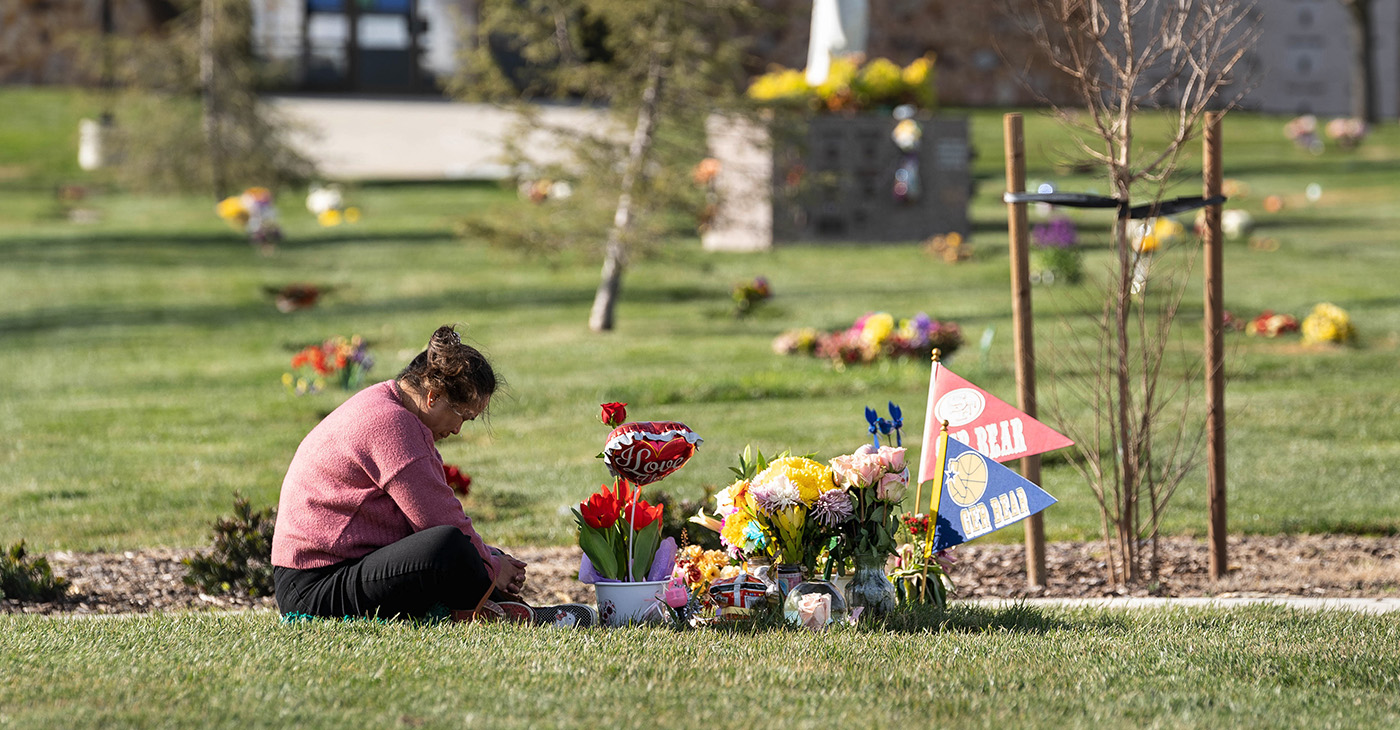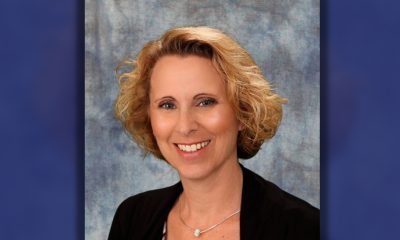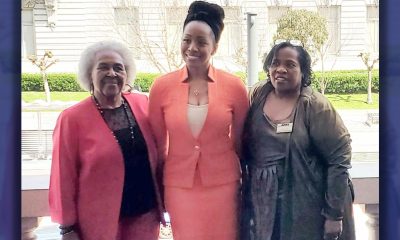#NNPA BlackPress
School District Sued by Family of 11-Year-Old Girl Who Died by Suicide After Alleged Bullying
By Katy St. Clair Bay City News In a time when many pre-teen antics are uploaded to TikTok and Instagram, a video out of Vallejo shared on social media last year holds something disturbing. In it, a sixth-grade girl stands in a school yard with her back to the camera, her long dark hair pulled […]
The post School District Sued by Family of 11-Year-Old Girl Who Died by Suicide After Alleged Bullying first appeared on BlackPressUSA.

By Katy St. Clair
Bay City News
In a time when many pre-teen antics are uploaded to TikTok and Instagram, a video out of Vallejo shared on social media last year holds something disturbing.
In it, a sixth-grade girl stands in a school yard with her back to the camera, her long dark hair pulled back into a ponytail and her bright pink backpack on her shoulders. Suddenly, an arm shoots out, reaches for the girl’s hair and yanks her down very hard, sending the child sprawling to the ground.
The 11-year-old girl in the pink backpack was Maria “Therese” Caguin and she took her own life on Jan. 2 because she was repeatedly bullied at her school, her parents said. Now they are suing the school district for allegedly allowing their daughter to be subjected to physical, cyber and verbal bullying.
Therese’s death shocked and horrified not only her parents, but the greater community. Parents are calling for something to be done about bullying at Hogan Middle School in Vallejo.
Therese’s sister set up a GoFundMe the day after her death to raise funds for her funeral.
“Yesterday my little sister Therese took her own life. My dad found her in her room. She was only 11 years old,” reads the post. “This has been the most unexpected and saddest thing we’ve had to endure as a family.”
The principal of Hogan Middle School, Rosalind Hines, referred all questions about Therese’s alleged bullying and death to the Vallejo City Unified School District, which did not comment on the girl’s death. Hines did send out a message to parents on Jan. 6 in the wake of Therese’s death.
“With a heavy heart, I share the news of the passing of one of our own,” she wrote. “This sudden loss will surely raise many emotions, concerns, and questions for our entire school, especially our students.”
Hines went on to say that mental health support staff would be made available.
The reaction on Facebook was a mixture of sadness and anger, with one poster saying, “Maybe they should have stated that this poor child committed suicide due to bullying at that school. Why sugar coat it? Those bullies should suffer consequences.”
Therese’s mother Vionalyn Caguin, a single mom who also has a 3-year-old son, said she has been “completely broken” by her daughter’s death, saying she had no idea how much she had been going through.
“She just kept it to herself,” said Caguin, who said she knew her daughter wasn’t thriving at school but she didn’t know the extent of her trauma.
Caguin said she felt her daughter was trying to protect her from concern because she knew life wasn’t easy for her single mother.
“She didn’t want me to worry, but I was always saying, ‘Mama’s here.’ I made sure I was always there for her,” she said.
Caguin repeatedly asked her daughter how she was doing at her new school. Therese began at Hogan in August and was having difficulty making friends. She was obedient, quiet and sweet, her mother said.
Still, after a few months at Hogan, her mom knew something was wrong and began trying to find a different school for her daughter, she said, though other schools had waiting lists.
Caguin said that she didn’t fully understand the scope of the bullying until after her daughter’s death and she saw the video of her being assaulted in the school yard.
“When I saw that video, I said, oh my God, it’s breaking my heart, because I didn’t know that it’s that bad,” she said through tears during a visit to her daughter’s grave in a Vallejo cemetery.
Caguin said the school had told her last fall that there was an “incident” involving her daughter and that the kids would “face consequences,” but that the school never told her the extent of what happened, and neither did her daughter.
According to the claim filed Thursday, the school allegedly assured Therese’s parents that they would “take reasonable and appropriate measures to stop the bullying endured by” their daughter.
“Hogan Middle School did nothing to intervene and stop the harassment and bullying and did not follow the policies and procedures to make sure that Decedent and other students on campus were not continually harassed and bullied,” reads the claim.
Though Therese didn’t confide in her mother, she did reach out to a teacher. On or about October or November, she emailed a teacher to say that she “wanted to die,” the family’s claim alleges.
The suit alleges that the school then “did nothing to intervene.”
“In cases such as this, it requires the maximum amount of attention to bring about change,” said attorney for the family Bryan Harrison. “You have a situation in which the parents have entrusted the faculty and administration with trust to care for and protect, what is most meaningful to us as parents — our children.”
He said, “For the staff and faculty to ignore repeated instances of bullying, and in this particular case, ignore actual notice from a child directly that the child was thinking about hurting herself as a result of bullying, it’s not just negligent, it’s grossly negligent.”
A spokesperson for the school district provided their approach to the problem of bullying.
“We have multiple ways to respond to bullying at Hogan Middle School and across the district,” said district spokesperson Celina Baguiao.
Baguiao said all campuses have mental health support providers, academic support providers, and a way to report bullying either directly or anonymously. She also said Vallejo schools contract with outside agencies about bullying, including governmental agencies and nonprofits. There is a care team at Hogan that meets weekly to discuss concerns and an “end of day huddle” with staff to check in with each other about occurrences throughout the day.
Another mother of a child at Hogan said that abuse her daughter faced at the hands of kids there and even a teacher ramped up after Therese’s suicide.
“My daughter’s depressed,” Lauren Keltz, mother of a 13-year-old girl currently at Hogan, said she told a school administrator. “She told me that she is feeling worthless and stupid and suicidal. And I said to the school, ‘I’m telling you right now … because of your guys’ lack of intervention, I’m going to hold you personally accountable.’”
Keltz said no one ever pulled her daughter aside to ask how she was doing.
She said initially the bullying at the school allegedly came from a teacher, who called her daughter “stupid” and “retarded.”
The teacher did not respond to a request for comment and the school district also declined to comment.
Keltz said the news of Therese’s death after her own daughter’s experience at the school horrified her and made her more determined to speak out about what she says is happening at Hogan.
Lawsuits against school districts for bullying are not that uncommon. Last August, the El Segundo Unified School District in Los Angeles County was ordered to pay $1 million in a suit filed on behalf of a 13-year-old girl who was bullied, with students going as far as creating a petition to end her life.
This February in Ocean County, New Jersey, a 14-year-old girl who was bullied took her own life and her alleged attackers have been charged with conspiracy to commit aggravated assault. The superintendent of schools in the community has also resigned as a result. The district is currently being sued for another case of alleged bullying as well.
For Therese’s family, suing the Vallejo district is a way to try to foster change.
“I don’t want my daughter’s life to be erased,” said Caguin. “I want something different from the school. Don’t ignore those things that are happening. Even if my daughter’s not coming back, they have to change.”
Copyright © 2023 Bay City News, Inc. All rights reserved. Republication, rebroadcast or redistribution without the express written consent of Bay City News, Inc. is prohibited. Bay City News is a 24/7 news service covering the greater Bay Area.
###
KatyStClair1639p03/03/23
CONTACT: Bryan Harrison, attorney for Caguin family bryan@h-klaw.com
Celina Baguiao, spokesperson for the Vallejo City Unified School District cbaguiao@vcusd.org
EDITORS PLEASE NOTE: Images related to this story can be obtained from the following Bay City News Service web links:
https://www.baycitynews.com/images/BCN-20230210-SUICIDE-01.jpg
Vionalyn Caguin sits at the grave of her 11-year-old daughter, Maria ‘Therese’ Caguin, at All Souls Cemetery in Vallejo, Calif., on Feb. 10, 2023. Maria took her life on Jan. 2, after being repeatedly bullied at Hogan Middle School in Vallejo. The family is suing the school district. (Ray Saint Germain/Bay City News)
https://www.baycitynews.com/images/BCN-20230210-SUICIDE-02.jpg
Vionalyn Caguin wipes away tears as she speaks about her 11-year-old daughter, Maria ‘Therese’ Caguin, at All Souls Cemetery in Vallejo, Calif., on Feb. 10, 2023. Maria took her life on Jan. 2, after being repeatedly bullied at Hogan Middle School in Vallejo. The family is suing the school district. (Ray Saint Germain/Bay City News)
https://www.baycitynews.com/images/BCN-20230210-SUICIDE-04.jpg
Vionalyn Caguin holds a photo album of photos of her 11-year-old daughter, Maria ‘Therese’ Caguin, at All Souls Cemetery in Vallejo, Calif., on Feb. 10, 2023. Maria took her life on Jan. 2, after being repeatedly bullied at Hogan Middle School in Vallejo. The family is suing the school district. (Ray Saint Germain/Bay City News)
https://www.baycitynews.com/images/BCN-20230210-SUICIDE-05.jpg
Vionalyn Caguin holds a photo album of photos of her 11-year-old daughter, Maria ‘Therese’ Caguin, at All Souls Cemetery in Vallejo, Calif., on Feb. 10, 2023. Maria took her life on Jan. 2, after being repeatedly bullied at Hogan Middle School in Vallejo. The family is suing the school district. (Ray Saint Germain/Bay City News)
https://www.baycitynews.com/images/BCN-20230210-SUICIDE-06.jpg
The grave of 11-year-old Maria ‘Therese’ Caguin at All Souls Cemetery in Vallejo, Calif., on Feb. 10, 2023. Maria took her life on Jan. 2, after being repeatedly bullied at Hogan Middle School in Vallejo. The family is suing the school district. (Ray Saint Germain/Bay City News)
https://www.baycitynews.com/images/BCN-20230210-SUICIDE-07.jpg
Vionalyn Caguin holds a photo album of photos of her 11-year-old daughter, Maria ‘Therese’ Caguin, at All Souls Cemetery in Vallejo, Calif., on Feb. 10, 2023. Maria took her life on Jan. 2, after being repeatedly bullied at Hogan Middle School in Vallejo. The family is suing the school district. (Ray Saint Germain/Bay City News)
/www/bcn/general/03/newsclip.23.03.03.16.42.01.1.txt
The post School District Sued by Family of 11-Year-Old Girl Who Died by Suicide After Alleged Bullying first appeared on Post News Group. This article originally appeared in Post News Group.
The post School District Sued by Family of 11-Year-Old Girl Who Died by Suicide After Alleged Bullying first appeared on BlackPressUSA.
#NNPA BlackPress
Beloved Actor and Activist Louis Cameron Gossett Jr. Dies at 87
NNPA NEWSWIRE — Louis Gossett Jr., the groundbreaking actor whose career spanned over five decades and who became the first Black actor to win an Academy Award as Best Supporting Actor for his memorable role in “An Officer and a Gentleman,” has died. Gossett, who was born on May 27, 1936, in Brooklyn, N.Y., was 87. Recognized early on for his resilience and nearly unmatched determination, Gossett arrived in Los Angeles in 1967 after a stint on Broadway.
The post Beloved Actor and Activist Louis Cameron Gossett Jr. Dies at 87 first appeared on BlackPressUSA.

By Stacy M. Brown
NNPA Newswire Senior National Correspondent
@StacyBrownMedia
Louis Gossett Jr., the groundbreaking actor whose career spanned over five decades and who became the first Black actor to win an Academy Award as Best Supporting Actor for his memorable role in “An Officer and a Gentleman,” has died. Gossett, who was born on May 27, 1936, in Brooklyn, N.Y., was 87. Recognized early on for his resilience and nearly unmatched determination, Gossett arrived in Los Angeles in 1967 after a stint on Broadway.
He sometimes spoke of being pulled over by law enforcement en route to Beverly Hills, once being handcuffed to a tree, which he remembered as a jarring introduction to the racial tensions of Hollywood. In his memoir “An Actor and a Gentleman,” Gossett recounted the ordeal, noting the challenges faced by Black artists in the industry. Despite the hurdles, Gossett’s talent shone brightly, earning him acclaim in groundbreaking productions such as “A Raisin in the Sun” alongside Sidney Poitier. His Emmy-winning portrayal of Fiddler in “Roots” solidified his status as a trailblazer, navigating a landscape fraught with racial prejudice.
According to the HistoryMakers, which interviewed him in 2005, Gossett’s journey into the limelight began during his formative years at PS 135 and Mark Twain Junior High School, where he demonstrated early leadership as the student body president. His passion for the arts blossomed when he starred in a “You Can’t Take It With You” production at Abraham Lincoln High School, catching the attention of talent scouts who propelled him onto Broadway’s stage in “Take A Giant Step.” His stellar performance earned him the prestigious Donaldson Award for Best Newcomer to Theatre in 1952. Though initially drawn to sports, Gossett’s towering 6’4” frame and athletic prowess led him to receive a basketball scholarship at New York University. Despite being drafted by the New York Knicks in 1958, Gossett pursued his love for acting, honing his craft at The Actors Studio under the tutelage of luminaries like John Sticks and Peggy Fury.
In 1961, Gossett’s talent caught the eye of Broadway directors, leading to roles in acclaimed productions such as “Raisin in the Sun” and “The Blacks,” alongside legends like James Earl Jones, Cicely Tyson, Roscoe Lee Brown, and Maya Angelou. Transitioning seamlessly to television, Gossett graced small screens with appearances in notable shows like “The Bush Baby” and “Companions in Nightmare.” Gossett’s silver screen breakthrough came with his role in “The Landlord,” paving the way for a prolific filmography that spanned over 50 movies and hundreds of television shows. From “Skin Game” to “Lackawanna Blues,” Gossett captivated audiences with his commanding presence and versatile performances.
However, his portrayal of “Fiddler” in Alex Haley’s groundbreaking miniseries “Roots” earned Gossett critical acclaim, including an Emmy Award. The HistoryMakers noted that his golden touch extended to the big screen, where his role as Sergeant Emil Foley in “An Officer and a Gentleman” earned him an Academy Award for Best Supporting Actor, making him a trailblazer in Hollywood history.
Beyond the glitz and glamour of Hollywood, Gossett was deeply committed to community activism. In 1964, he co-founded a theater group for troubled youth alongside James Earl Jones and Paul Sorvino, setting the stage for his lifelong dedication to mentoring and inspiring the next generation. Gossett’s tireless advocacy for racial equality culminated in the establishment of Eracism, a nonprofit organization dedicated to combating racism both domestically and abroad. Throughout his illustrious career, Gossett remained a beacon of strength and resilience, using his platform to uplift marginalized voices and champion social change. Gossett is survived by his children, Satie and Sharron.
The post Beloved Actor and Activist Louis Cameron Gossett Jr. Dies at 87 first appeared on BlackPressUSA.
#NNPA BlackPress
COMMENTARY: D.C. Crime Bill Fails to Address Root Causes of Violence and Incarceration
WASHINGTON INFORMER — The D.C. crime bill and so many others like it are reminiscent of the ‘94 crime bill, which produced new and harsher criminal sentences, helped deploy thousands of police and surveilling methods in Black and brown communities, and incentivized more states to build prisons through a massive infusion of federal funding. While it is not at the root of mass incarceration, it significantly accelerated it, forcing a generation of Black and brown families into a never-ending cycle of state-sanctioned violence and incarceration.
The post COMMENTARY: D.C. Crime Bill Fails to Address Root Causes of Violence and Incarceration first appeared on BlackPressUSA.

By Kaili Moss and Jillian Burford | Washington Informer
Mayor Bowser has signed the “Secure DC” omnibus bill passed by the D.C. Council last month. But we already know that this bill will be disastrous for all of D.C., especially for Black and brown residents.
While proponents claim that this legislation “will make D.C. residents safer and more secure,” it actually does nothing to address the root of the harm in the first place and instead maintains a cycle of violence, poverty, and broken community ties. The omnibus bill calls for increased surveillance, drug-free zones, and will expand pre-trial detention that will incarcerate people at a significantly higher rate and for an indeterminate amount of time before they are even tried. This bill will roll back decades of nationwide policy reform efforts and initiatives to keep our communities safe and whole, which is completely contradictory to what the “Secure” D.C. bill claims it will do.
What is unfolding in Washington, D.C., is part of a dangerous national trend. We have seen a resurrection of bad crime bills in several jurisdictions across the country — a phenomenon policy experts have named “zombie laws,” which are ineffective, costly, dangerous for communities of color and, most importantly, will not create public safety. Throwing more money into policing while failing to fund preventative measures does not keep us safe.
The D.C. crime bill and so many others like it are reminiscent of the ‘94 crime bill, which produced new and harsher criminal sentences, helped deploy thousands of police and surveilling methods in Black and brown communities, and incentivized more states to build prisons through a massive infusion of federal funding. While it is not at the root of mass incarceration, it significantly accelerated it, forcing a generation of Black and brown families into a never-ending cycle of state-sanctioned violence and incarceration. Thirty years later, despite spending billions each year to enforce these policies with many of these provisions remaining in effect, it has done very little to create long-term preventative solutions. Instead, it placed a permanent moving target on the backs of Black people, and the D.C. crime bill will do the same.
The bill calls for more pretrial detention. When our loved ones are held on pretrial detention, they are held on the presumption of guilt for an indeterminate amount of time before ever seeing a judge, which can destabilize people and their families. According to experts at the Malcolm Weimer Center for Social Policy at Harvard University, just one day in jail can have “devastating consequences.” On any given day, approximately 750,000 people are held in jails across the nation — a number that beats our nation’s capital population by about 100,000. Once detained, people run the risk of losing wages, jobs, housing, mental and health treatments, and time with their families. Studies show that pretrial detention of even a couple of days makes it more likely for that person to be rearrested.
The bill also endangers people by continuing a misguided and dangerous War on Drugs, which will not get drugs off the street, nor will it deter drug use and subsequent substance use disorders (SUDs). Drug policies are a matter of public health and should be treated as such. Many states such as Alabama, Iowa and Wisconsin are treating the current fentanyl crisis as “Crack 2.0,” reintroducing a litany of failed policies that have sent millions to jails and prisons instead of prioritizing harm reduction. Instead, we propose a simple solution: listen to members of the affected communities. Through the Decrim Poverty D.C. Coalition, community members, policy experts and other stakeholders formed a campaign to decriminalize drugs and propose comprehensive legislation to do so.
While there are many concerning provisions within the omnibus bill, car chases pose a direct physical threat to our community members. In July 2023, NBC4 reported that the D.C. Council approved emergency legislation that gave MPD officers the ability to engage in vehicular pursuits with so-called “limited circumstances.” Sgt. Val Barnes, the head of MPD’s carjacking task force, even expressed concern months before the decision, saying, “The department has a pretty strict no-chase policy, and obviously for an urban setting and a major metropolitan city, that’s understandable.” If our law enforcement officers themselves are operating with more concern than our elected officials, what does it say about the omnibus bill’s purported intention to keep us safe?
And what does it mean when the risk of bodily harm is posed by the pursuit itself? On Saturday, Feb. 10, an Eckington resident had a near-miss as a stolen car barreled towards her and her dog on the sidewalk with an MPD officer in pursuit. What responsibility does the city hold if this bystander was hit? What does restitution look like? Why are our elected officials pushing for MPD officers to contradict their own policies?
Just a few summers ago during the uprisings of 2020, we saw a shift in public perspectives on policing and led to legislation aimed at limiting police power after the highly-publicized murders of loved ones Breonna Taylor and George Floyd — both victims of War on Drugs policing and the powers gained from the ’94 crime bill. And yet here we are. These measures do not keep us safe and further endanger the health of our communities. Studies show that communities that focus on harm reduction and improving material conditions have a greater impact on public safety and community health. What’s missing in mainstream conversations about violent crime is the violence that stems from state institutions and structures that perpetuate racial and class inequality. The people of D.C. deserve to feel safe, and that includes feeling safe from the harms enacted by the police.
Kaili Moss is a staff attorney at Advancement Project, a national racial justice and legal organization, and Jillian Burford is a policy organizer at Harriet’s Wildest Dreams.
The post COMMENTARY: D.C. Crime Bill Fails to Address Root Causes of Violence and Incarceration first appeared on BlackPressUSA.
#NNPA BlackPress
Mayor, City Council President React to May 31 Closing of Birmingham-Southern College
THE BIRMINGHAM TIMES — “This is a tragic day for the college, our students, our employees, and our alumni, and an outcome so many have worked tirelessly to prevent,” Rev. Keith Thompson, chairman of the BSC Board of Trustees said in an announcement to alumni. “We understand the devastating impact this has on each of you, and we will now direct our efforts toward ensuring the smoothest possible transition for everyone involved.”
The post Mayor, City Council President React to May 31 Closing of Birmingham-Southern College first appeared on BlackPressUSA.

By Barnett Wright | The Birmingham Times
Birmingham-Southern College will close on May 31, after more than a century as one of the city’s most respected institutions.
“This is a tragic day for the college, our students, our employees, and our alumni, and an outcome so many have worked tirelessly to prevent,” Rev. Keith Thompson, chairman of the BSC Board of Trustees said in an announcement to alumni. “We understand the devastating impact this has on each of you, and we will now direct our efforts toward ensuring the smoothest possible transition for everyone involved.”
There are approximately 700 students enrolled at BSC this semester.
“Word of the decision to close Birmingham Southern College is disappointing and heartbreaking to all of us who recognize it as a stalwart of our community,” Birmingham Mayor Randall Woodfin said in a statement. “I’ve stood alongside members of our City Council to protect this institution and its proud legacy of shaping leaders. It’s frustrating that those values were not shared by lawmakers in Montgomery.”
Birmingham City Council President Darrell O’Quinn said news of the closing was “devastating” on multiple levels.
“This is devastating for the students, faculty members, families and everyone affiliated with this historic institution of higher learning,” he said. “It’s also profoundly distressing for the surrounding community, who will now be living in close proximity to an empty college campus. As we’ve seen with other institutions that have shuttered their doors, we will be entering a difficult chapter following this unfortunate development … We’re approaching this with resilience and a sense of hope that something positive can eventually come from this troubling chapter.”
The school first started as the merger of Southern University and Birmingham College in 1918.
The announcement comes over a year after BSC officials admitted the institution was $38 million in debt. Looking to the Alabama Legislature for help, BSC did not receive any assistance.
This past legislative session, Sen. Jabo Waggoner sponsored a bill to extend a loan to BSC. However, the bill subsequently died on the floor.
Notable BSC alumni include former New York Times editor-in-chief Howell Raines, former U.S. Sen. Howell Heflin and former Alabama Supreme Court Chief Justice Perry O. Hooper Sr.
This story will be updated.
The post Mayor, City Council President React to May 31 Closing of Birmingham-Southern College first appeared on BlackPressUSA.
-

 Activism4 weeks ago
Activism4 weeks agoOakland Post: Week of March 27 – April 2, 2024
-

 #NNPA BlackPress4 weeks ago
#NNPA BlackPress4 weeks agoCOMMENTARY: D.C. Crime Bill Fails to Address Root Causes of Violence and Incarceration
-

 #NNPA BlackPress4 weeks ago
#NNPA BlackPress4 weeks agoMayor, City Council President React to May 31 Closing of Birmingham-Southern College
-

 #NNPA BlackPress4 weeks ago
#NNPA BlackPress4 weeks agoBeloved Actor and Activist Louis Cameron Gossett Jr. Dies at 87
-

 Community1 week ago
Community1 week agoFinancial Assistance Bill for Descendants of Enslaved Persons to Help Them Purchase, Own, or Maintain a Home
-

 Activism3 weeks ago
Activism3 weeks agoOakland Post: Week of April 3 – 6, 2024
-

 Business1 week ago
Business1 week agoV.P. Kamala Harris: Americans With Criminal Records Will Soon Be Eligible for SBA Loans
-

 Activism2 weeks ago
Activism2 weeks agoOakland Post: Week of April 10 – 16, 2024


















































